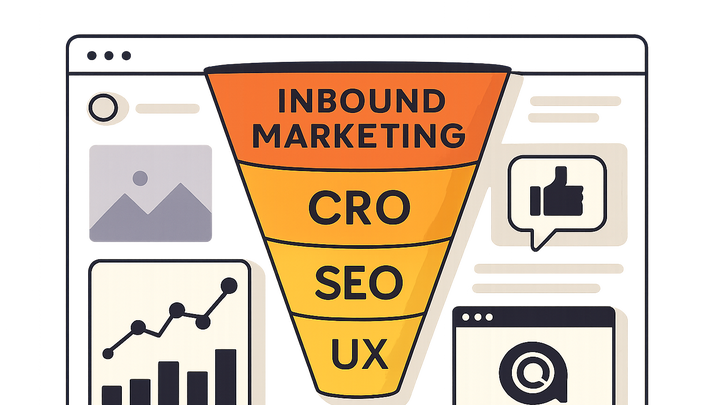Published on 2025-06-29T22:00:57Z
What is Inbound Marketing? Examples for Inbound Marketing
Inbound Marketing is a holistic strategy in the CRO/UX/SEO space that focuses on:
- Attracting qualified visitors with relevant content
- Engaging them through seamless user experiences
- Converting them into leads and customers
Rather than using interruptive tactics, inbound marketing leverages blog articles, SEO-optimized landing pages, interactive tools, and social media to nurture prospects. Tools like Prevue.me can audit your site’s content, design, and technical performance to ensure that every touchpoint in your inbound strategy is optimized. By integrating content marketing, technical SEO, and user-centered design, inbound marketing delivers sustainable growth, higher conversion rates, and better ROI.
Inbound marketing
Inbound marketing uses content, UX, and SEO to attract, engage, and delight prospects, driving organic traffic and conversions.
Why Inbound Marketing Matters
Inbound marketing aligns perfectly with CRO, UX, and SEO by creating a cohesive journey: attracting the right audience, reducing friction, and guiding visitors toward conversion through valuable content and optimized experiences.
-
Aligned content strategy
Crafting content tailored to your target personas drives organic traffic and builds trust over time.
- Buyer personas:
Define ideal customer profiles to shape relevant messaging and offers.
- Content mapping:
Match content types to each stage of the buyer’s journey for maximum impact.
- Buyer personas:
-
Enhanced user experience
A seamless UX reduces friction, keeps visitors engaged longer, and boosts the likelihood of conversion.
- Responsive design:
Ensure your site adapts fluidly across devices and screen sizes.
- Accessibility:
Implement WCAG guidelines to make your content usable for all users.
- Responsive design:
-
Search engine optimization
Optimizing both on-page and technical elements improves visibility and attracts qualified prospects.
- Keyword research:
Identify terms your audience uses and integrate them naturally into your content.
- Technical seo:
Optimize site speed, crawlability, and schema markup for better ranking potential.
- Keyword research:
Key Components of Inbound Marketing
Inbound marketing is structured around three core stages—Attract, Engage, and Delight—each tying back to CRO, UX, and SEO practices.
-
Attract: drawing in the right audience
Use SEO-optimized blog posts, social media, and targeted ads to pull in qualified visitors.
- Blogging:
Publish educational articles that address user pain points and keywords.
- Seo optimization:
Optimize on-page elements like meta titles, headings, and internal links.
- Blogging:
-
Engage: converting visitors
Turn visitors into leads with compelling CTAs, landing pages, and lead magnets.
- Landing pages:
Design focused pages that highlight value propositions and minimize distractions.
- Lead magnets:
Offer ebooks, templates, or webinars to capture email addresses.
- Landing pages:
-
Delight: retaining and upselling
Nurture leads with personalized emails and content to turn them into promoters.
- Email nurturing:
Send targeted sequences that address the prospect’s stage and interests.
- Personalized content:
Use dynamic content to deliver relevant offers and recommendations.
- Email nurturing:
Applying Prevue.me for Inbound Marketing
prevue.me provides automated critiques across CRO, SEO, UX, and accessibility, helping you optimize each stage of your inbound funnel.
-
Website critiques for cro and lead generation
Analyze landing pages to uncover friction points and improve form designs, CTAs, and value propositions.
- Actionable insights:
Receive clear, prioritized recommendations to boost conversions.
- Actionable insights:
-
Seo audits and recommendations
Identify on-page and technical SEO issues, uncover ranking opportunities, and fix errors.
- On-page optimization:
Get guidance on meta tags, headings structure, and content relevance.
- Technical fixes:
Improve site speed, mobile performance, and crawlability.
- On-page optimization:
-
Ux & accessibility insights
Highlight design inconsistencies and accessibility barriers to create an inclusive user experience.
- Wcag compliance:
Ensure your site meets accessibility standards for all users.
- Usability heuristics:
Implement proven UI patterns to streamline navigation and engagement.
- Wcag compliance:
Best Practices and Tips
Maximize inbound marketing results by continuously testing, measuring, and refining your strategy in alignment with CRO, UX, and SEO insights.
-
Continuous a/b testing
Experiment with headlines, CTAs, and page layouts to discover what resonates best.
- Hypothesis-driven tests:
Define clear goals and expected outcomes before each experiment.
- Statistical significance:
Run tests long enough and with sufficient traffic to trust the results.
- Hypothesis-driven tests:
-
Data-driven optimization
Leverage analytics and prevue.me reports to prioritize improvements based on real user behavior.
- Analytics tracking:
Monitor key metrics like bounce rate, time on page, and conversion funnels.
- Dashboards & alerts:
Set up real-time monitoring to detect performance drops quickly.
- Analytics tracking:
-
Integrated content and technical strategy
Ensure marketing, design, and development teams collaborate on content and SEO roadmaps.
- Cross-functional collaboration:
Hold regular syncs to align goals, timelines, and responsibilities.
- Content calendars:
Plan topics that support both user intent and SEO objectives over time.
- Cross-functional collaboration:
